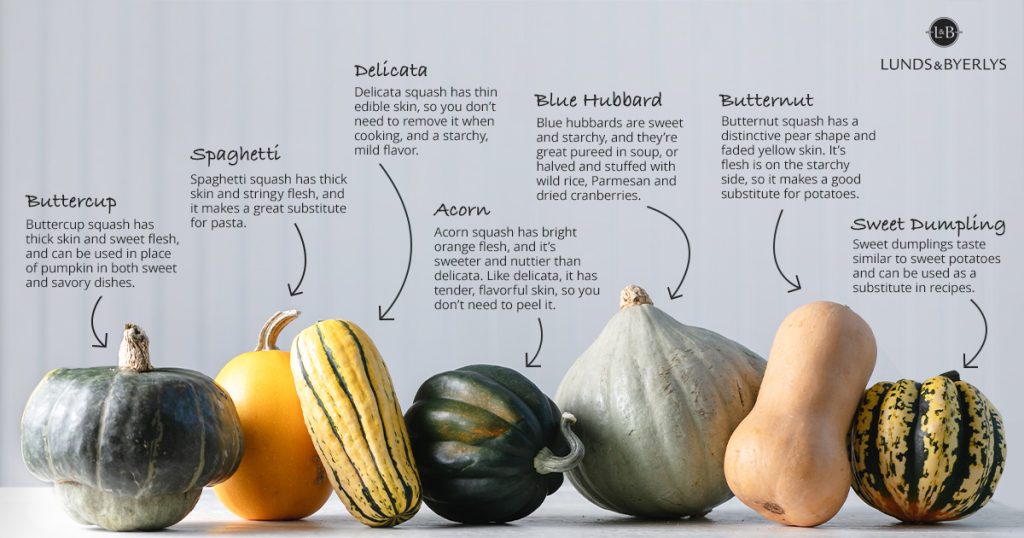L&B Guide to Winter Squash
November 18, 2022
In the Lunds & Byerlys test kitchen, we swoon for winter squash. They’re delicious, of course, and easy to store and prepare. They’re healthy, too. But what really seals the deal for us — what makes them the teacher’s pet of winter veggies — is their beauty. What other seasonal food can brighten up a dinner plate so easily this time of year? The deep oranges and warm yellows of winter squash bring a much needed ray of sunshine to winter meals.
And did we mention their versatility? Most winter squash have a mild, sweet flavor and a buttery texture, making them fabulous in both sweet and savory dishes; they pair well with an untold number of spices; they can be turned into hummus, transformed into pie, cubed and put in stews or used as a replacement for pasta. They’re superb pureed in soup. Store them in a cool, dark place, and their thick skins will keep them fresh through the long winter months. (Some exceptions apply: Acorn squash and delicata squash have thin, edible skins and won’t keep as long. They’re also more susceptible to bruising.)
We sat down with our chefs to get their take on winter squash. Which are which? What are they best for? Here’s what they had to say.

Buttercup
Buttercup squash are stout and dark green, with lighter green and gray striations running from top to bottom. You can tell a buttercup from other varieties by looking at the base, which is shaped like a spinning top (the vintage child’s toy) surrounded by a hard, circular ridge. They have thick, tough skins and sweet, orange flesh, and can be used as a replacement for pumpkin in both savory and sweet pumpkin dishes.
Buttercup squash is terrific in soups or cubed and added to stews. Try seasoning buttercup squash with curry spices or maple syrup, or layer it with apples and roast it in the oven. It will come out very sweet with a creamy, buttery texture that’s hard to resist. Buttercup can also be used in place of pumpkin when making pumpkin pie.
Spaghetti
Spaghetti squash is a real treat. It’s got thick, yellow skin and a classic round shape, but the fun really starts when you get to the flesh, which is starchy, stringy and not at all sweet.
The stringy flesh makes a fantastic pasta replacement in any dish that calls for pasta, and the round shape and denser flesh closer to the skin make delicious, stuffable boats, as in our Spaghetti Squash Lasagna Bowls. The thick skin can be a bear to cut through, so make sure your knife is sharp and your cutting board is secure. Once the slicing and dicing is done, spaghetti squash is a breeze to prepare. We like to toss al dente spaghetti squash with pancetta, sun-dried tomatoes, nuts and pesto for an easy dinner.
Delicata
Most winter squash have tough, sturdy, inedible rinds, but not the delicata. The skin is edible and soft when cooked, so no need to remove it, and the flavor is starchy and mild. They’re great halved, seeded and sliced into half-inch pieces and roasted. Our friend @greensandchocolate roasted them and tossed them with wild rice to make this delicious Cranberry & Squash Wild Rice Salad, or keep it simple (but still fancy) with our recipe for Delicata Squash Crostini or Maple Holiday-Spiced Roasted Delicata Squash.
Eat them as a side dish, toss them in salads or place them on a fall charcuterie board with some dip. If you want a treat for your tastebuds and your eyes, make the most of the skin’s well-defined ridges and vibrant colors by cutting your squash in half and using them as bowls.
Acorn
Acorn squash have dark green skins and bright orange flesh, and they’re slightly sweeter and nuttier than delicata. But just like delicata, they have thin, tender and flavorful skins, so you don’t need to peel them.
Acorn squash are perfect for filling and roasting; one of our favorite ways to stuff an acorn squash is with grains, sage and more veggies. Turning them into beautiful bowls is a full sensory experience.
Blue Hubbard
If ‘go big or go home’ is your motto, the blue hubbard is your squash. These large gourds have pale blue to grayish-blue skin and bright orange flesh. They’re sweet and starchy, and they’re great pureed in soup, roasted or halved and stuffed with a grain like quinoa or wild rice, some Parmesan and dried cranberries or raisins. Blue hubbards can be unwieldy to cut and peel. Look for cut blue hubbards if you’re pressed for time or wary of prepping this hard-skinned gourd.
Butternut
Butternut squash is one of the classics. It has a distinctive pear shape and faded yellow skin, and it is very sweet and nutty. It’s on the starchy side, so it makes a good substitute for potatoes — its creamy flesh makes it a dream for mashing — but it works beautifully almost any way you want to use it: roasted alongside other veggies, thinly sliced and added to galettes and puff pastries and pureed into soups.
We’ve used it in Missouri River Pozole, Butternut Squash and Apple Soup, and Butternut Squash and Black Bean Enchilada Casserole. Butternut skins are thick and require patience to peel. Pick up some cubed butternut squash when you want a dinner that is delicious and easy.
Sweet Dumpling
As their name implies, sweet dumplings are darling. They have festive yellow and green stripes, they’re small and stout and their flesh is sweet and buttery. They taste similar to sweet potatoes and can be used as sweet potato substitutes in recipes. They make great bowls, too, thanks to their small size and compact shape.
Use sweet dumplings in any way you would use other winter squash: roasted, stuffed or pureed in soup. Because they’re so sweet, they make great substitutes for pumpkin when making pumpkin pie. Bonus: You can call your pie a sweet dumpling pie — and how sweet is that!










